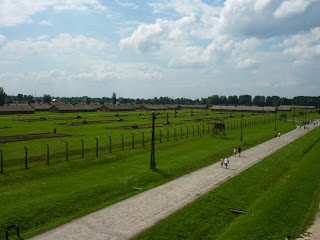So we drove on from Oswiecim to Cracow, taking the blue highways, as we often do. The secondary roads we saw in Poland are pretty much as advertised: paved, wide enough, but very rough and heavily-trafficked. The one-hour drive to Cracow took two hours, but we got to see some "real" Poland that you don't see from the super-highway.
We spent a couple days in Cracow. The campground was near Borek, in the western outskirts, with the tram station and a huge shopping center a few hundred feet beyond the park. This campground also had free wifi, in the reception area only, however. Riding into the old city was a breeze. And cheap.
Cracow is the historic, cultural, and intellectual capital of Poland. Somehow, it avoided the ravages of two world wars. The modern capital, Warsaw, was pretty much destroyed in WWII. Old Cracow is beautiful, interesting, studded with fascinating architecture, some of it quite old. Of course, newer Cracow is old eastern bloc, neither beautiful nor interesting.... But then, most all cities are like this, everywhere.
 |
The St. Mary Church, 14th century, dominates the old city market square |
 |
Its best known feature is the large wood-carving alterpiece by Veit Stoss of Nuremburg |
 |
Up closer; larger than life-size |
 |
Stained-glass window; extremely ornate throughout; memorials of one sort or another occupy just about every square inch, sort of like Westminster Abbey |
 |
Ceiling |
 |
Front of another church, down the street |
 |
Many beautiful buildings |
 |
And my personal favorite, the statue of Copernicus, in the university area; he was a student there; the U of Cracow is one of Europe's very oldest |
 |
Typical Cracow tram |















































